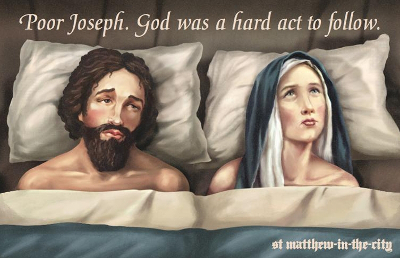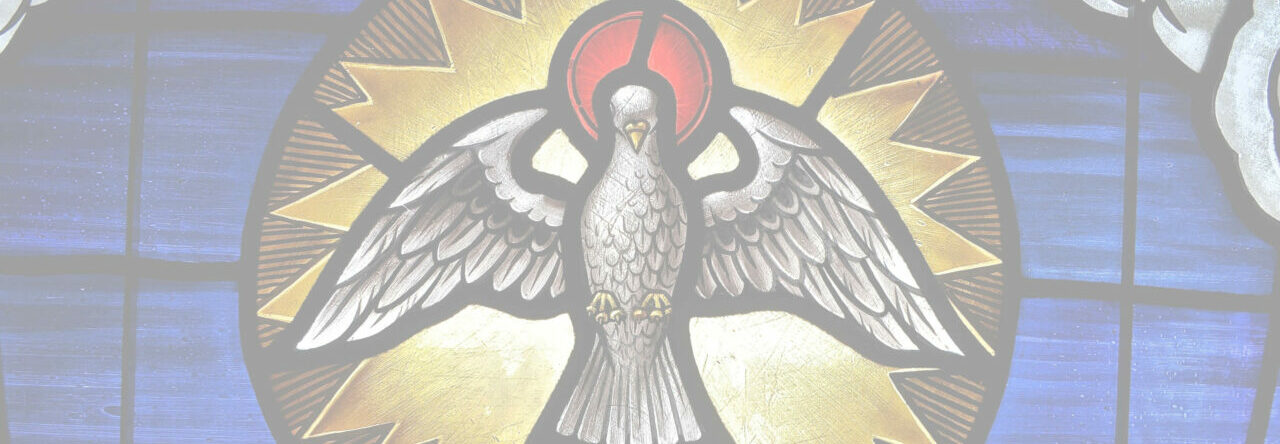It’s Christmas day, get off the internet!
 Just recently I blogged on the billboard erected by St Matthew-in-the-city. I said at the time that it was an act of desperation from a brand of religion that wants to effectively give up its religious nature but still retain its spot in the church, jettisoning anything that might connect it to (eeeew) Christianity, and trying to be hip and risque by poking crass fun at Christianity itself.
Just recently I blogged on the billboard erected by St Matthew-in-the-city. I said at the time that it was an act of desperation from a brand of religion that wants to effectively give up its religious nature but still retain its spot in the church, jettisoning anything that might connect it to (eeeew) Christianity, and trying to be hip and risque by poking crass fun at Christianity itself.
Although whoever comes up with ideas like this is apparently in the bizarre headspace where he/she thinks that the non-Christian world will admire this, the reality is somewhat different. For quite some time now I have consistently noticed that such tactics never achieve the stated (although probably false) goal of “getting people to think” or “encouraging serious dialogue” about faith in the modern world. Claiming Christianity while rejecting God and virtually everything that the Christian faith teaches does not make people look credible. It makes them look ridiculous. Genuine sceptics toward Christianity simply see straight through these attempts to be relevant as a way of selling out and living a ruse.
While I don’t share her take on the meaning of Christmas (largely because it sounds like she attributes no theological importance to it at all – and because of her heretical comment about guitars in church), I did appreciate the comments of the ever lovely Kerre Woodham in the New Zealand Herald:
I do wish churches would get back to core business and start laying down the moral law, delivering thundering nightmare-inducing sermons and ministering to the poor.
My dad always said no good would come of allowing guitars and folk songs into services, and he was right. All this faffing around trying to be edgy and relevant is embarrassing. It’s like watching your parents dance.
St Matthew-in-the-City is the latest culprit, with its Saatchi & Saatchi-generated billboard depicting a dejected looking Joseph and a disappointed Mary in bed. The caption read: “Poor Joseph. God is a hard act to follow.” Implying, of course, that God is the Man – capital “M” – in the sack and Joseph is a poor second.
The billboard has generated much debate, with some saying it’s offensive and others saying religious maniacs need to lighten up. Predictably, Family First is in the offended camp.
But really, Bob McCroskrie’s great-great-grandfather was probably the first man to cover the legs of pianos in Victorian England, so as not to offend the sensibilities of the ladies. The Catholic Church had a milder response, saying the billboard was inappropriate and disrespectful.
On the other hand, archdeacon Glynn Cardy is beside himself with excitement, saying the agency has fulfilled the brief. He says the church wanted to get people to think more about the meaning of Christmas. Is it about a spiritual male God sending down sperm so a child would be born, or is it about the power of love in our midst, as seen in Jesus?
Although I don’t think the billboard was especially offensive, I think it was probably just a bit too arch. I don’t know about you, but Christmas has never been about God and sperm. It’s a time to be with people you love, sharing what you have with those who might need a bit of help and for me, it’s about doing a moral stock take. How much have I done for others this year, and what more could I do? Not wondering whether bodily fluids were ever mingled between God and Mary – or for that matter, Joseph and Mary. St Matthew-in-the-City prides itself on being “at the progressive end of the Christian continuum”, but the way it’s promoting itself, its future seems more assured as a venue for fashion shows rather than a place of worship.
[Emphasis added]
As one person said on St Matthew’s website: “Glynn Cardy, As one atheist to another, take my advice: get yourself out of the Church and try working for a living.” People can see straight through the absurdity of rejecting everything that makes Christianity distinctively Christian while trying to retain a position among its ranks (and even drawing a paycheck from it!). In spite of the claims about encouraging thought and discussion, the stunt has not worked. It has caused a lot of people to notice how antithetical to Christianity the action was, it has caused umbrage among plenty of Christians, and it has sent the liberal defenders of such messages to become extremely defensive, disappointed that the outcome – amazingly – was not in their favour. In a word, “duh.” This self-serving publicity gimmick failed to get anyone talking seriously about the meaning of christmas. It failied to stir up any genuine theological discussion of any kind, as far as I can tell. All it did (as was probably the plan all along) was to get people talking about Glynn Cardy and his church. Well, he got it, in spite of the fact that he might not have liked the way it turned out. That anyone at St Matthews might have hoped for anything other than what they got just demonstrates how painfully out of touch with reality they really are.
Glenn Peoples

The grinches are at it again. Every year at Easter and Christmas the tired old wheels start squeaking and some of the detractors of Christianity start wheeling out a few predictable canards, all connected to the idea that Christianity is just a copycat religion and that the accounts of the life of Jesus of Nazareth that we have in the New Testament were just borrowed from other older religions.
Generally these attempts are now limited to personal websites and message boards on the internet, as they are so discredited that bringing them up at, say, a conference on New Testament studies, would get one laughed all the way home. But, unhappily resigned to the fact that some people only know what they know about theology or biblical studies because they read it at a website, it’s worth addressing some of these claims.
I’ve already dealt with the claim that the virgin birth was borrowed from Buddhism and the claim that Jesus’ life is just a re-hashed version of the life of Osiris. Another common “copycat” theory that floats around online is the claim that Jesus is a mythical character copied from Mithras.1
- Although there is a Mithra and a Mithras in different ancient traditions, the copycat theory that I frequently observed makes no distinction between them. [↩]
St Matthew-in-the-City Anglican church in downtown Auckland offended a few people with a Christmas billboard.

I can’t think how…
Archdeacon Glynn Cardy dubs the church’s brand of faith as “Progressive Christianity.” It’s a faith that “believes the Christmas stories are fictitious accounts designed to introduce the radical nature of the adult Jesus.” What’s surprising is that the Rev Cardy actually appears to think that this is a good humoured lampoon against traditional, orthodox Christianity. As everyone knows, historic Christianity teaches that God had sex with Mary, right?
How can ludicrous caricatures like this possibly portray liberal/progressive Christianity as anything other than juvenile and ignorant (or perhaps dishonest, misrepresenting the faith of others so as to burn a straw man). Click the link at the start of this post, and what you’ll see, unfortunately, is more of the same misrepresentation and false bravado at the courage involved in crass religious humour.
The billboard didn’t last, and has been vandalised already, little more than five hours after it went up. I’m no fan of vandalism of course, but people can hardly be amazed here. Imagine a billboard along the lines of “Jews, for the last time: It’s just a wall. Get over it” or “Ah, Hillary Clinton. Imagine thinking that a woman could become anything.” It would hardly wash to say “All we really want is to lampoon women,” or “But we were only making fun of Jews. JEWS!” It’s an ironic twist that in a rather self serving defence, maintining that Jesus is all about accepting the rejects and rejecting the powerful, this church is actually offering a justification for attempting to publicly make fun of mainstream Christianity and write it off as “fundamentalist,” apparently banking on the fact that it will be unpopular (rejected?) enough that not too many people will care.
The fact is, so called “progressive” Christianity has few reservations about stunts like this because it has little to offer and is somewhat desparate. Within, for example the Presbyterian and Anglican churches here in New Zealand, they are losing the war and are a shrinking voice, fading into the oblivion of obscurity. By contrast, evangelical congregations are on the rise and at a national level the decisions being made are more in keeping with traditional Christian belief than ever before in the last 30 years. People are (for what I take to be obvious reasons) taking seriously the fact that it’s frankly a bit facile to expect to be given church resources as well as recognition as a Christian movement while denying more or less all of the truth claims of the Christian faith, from the resurrection of Jesus to the virgin birth, or even in many cases the very existence of God.
It isn’t a surprise that the churches that are experiencing growth are the evangelical churches that do not try to divorce the moral aspects of Christianity from its claims about reality. I have no reason to think that attention-seeking tactics like these are going to change that.
Glenn Peoples
By reason! No…. wait… that’s not it…. Ah yes, politics and force.
Props to Whale Oil for drawing my attention to this.
 Whatever else he thinks about anything, Professor Robert Winston just won some brownie points with me. He calls the worship of New Zealand’s celebrities a “false idolatry” that glorifies traits that, in the big picture, really don’t matter all that much.
Whatever else he thinks about anything, Professor Robert Winston just won some brownie points with me. He calls the worship of New Zealand’s celebrities a “false idolatry” that glorifies traits that, in the big picture, really don’t matter all that much.
Lord Winston believes Kiwis do not value intellectuals and ignore the worst behaviour of our sports stars. “New Zealand celebrates attributes which really aren’t that important,” he said.
“You do it with sportsmen and you don’t do it particularly with intellectuals, for example. In New Zealand, being an intellectual is slightly disadvantageous and is often seen by the press as being something which is rather well, not to be celebrated.
“On the other hand, if you are a great rugby player, maybe parts of your private life which are pretty appalling, will go ignored.
Check out the audio at the news story.
If I had a Christmas list, Winston would be on it.
Glenn Peoples
 Here’s part three of the series on philosophy of mind. We’ve moved from dualism in part one through to physicalism in this episode. I look at epiphenomenialism, reductionism, nonreductive physicalism and a constitution view.
Here’s part three of the series on philosophy of mind. We’ve moved from dualism in part one through to physicalism in this episode. I look at epiphenomenialism, reductionism, nonreductive physicalism and a constitution view.
As promised, here’s some suggested reading for those who want to look into the subject futher:
Nancey Murphy, “Nonreductive Physicalism and Free Will” http://www.metanexus.net/magazine/tabid/68/id/10501/Default.aspx
Nancey Murphy, “Is “Nonreductive Physicalism” an Oxymoron?” http://www.metanexus.net/magazine/tabid/68/id/10865/Default.aspx
Nancey Murphy and Warren Brown, Did My Neurons Make Me Do It?: Philosophical and Neurobiological Reflections on Moral Responsibility and Free Will (Oxford University Press, 2009).
Joel B. Green and Stuart L. Palmer (eds), In Search of the Soul: Four Views of the Mind-Body Problem (Downers Grove: InterVarsity, 2005). This volume includes contributions from Stewart Goetz (Substance Dualism), William Hasker (Emergent Dualism), Nancey Murphy (Nonreductive Physicalism) and Kevin Corcoran (Constitution View).
Joel B. Green (ed.), What About the Soul?: Neuroscience and Christian Anthropology (Abingdon Press, 2001). This volume includes contributions from Bill T. Arnold, D. Gareth Jones, Joel B. Green, Patrick D. Miller, Charles E. Gutenson, Stuart L. Palmer, William Hasker, Michael Rynkiewich, Virginia T. Holeman, Lawson G. Stone and Malcolm Jeeves.
Warren S. Brown, Nancey Murphy and H. Newton Maloney (eds), Whatever Happened to the Soul: Scientific and Theological Portraits of Human Nature (Augsburg Fortress, 1998). This volume includes contributions from Nancey Murphy, H. Newton Malony, Ray S. Anderson, V. Elving Anderson, Francisco J. Ayala, Warren S. Brown Jr., Joel B. Green, Malcolm Jeeves, H. Newton Malony and Stephen G. Post.
Kevin Corcoran, Rethinking Human Nature: A Christian Materialist Alternative to the Soul (Baker Academic, 2006).
The website of Timothy O’Connor, featuring a number of articles.
Happy reading, and I hope you find this episode interesting! 🙂
Glenn Peoples
Podcast: Play in new window | Download
UPDATE: Here the whole series, now that it is complete:

Mark Strom
Mark Strom has been the principal of Laidlaw College for nearly five years now. When I was there from 1999 – 2001 it was the Bible College of New Zealand. His five year contract is up for renewal in January 2010, and he has indicated that he will stay on until September 2010 at which time he will take his study leave, ending his time as principal.
From Laidlaw’s press release a couple of days ago:
“During his term as Principal, Mark has undertaken a recalibration of Laidlaw College, retaining its strong biblical focus, while moving towards training students not only for mission and pastoral work, but also for engagement with society at all levels”, says National Governing Council Chair Graham Burt. “Mark has inspired staff and students alike towards this goal. We greatly appreciate his contribution.”
Mark’s time in office has seen some big changes for the college, and all for the better. First was the re-branding and re-naming of the college, taking the name of Robert Laidlaw (a worthy New Zealand name if ever there was one). Secondly however, during Mark’s time the college has made a turn towards a more robust vision of Christian scholarship. While papers and courses in biblical studies, theology, church history and missions have obviously continued, major developments have beenmade in the school of counselling, and very positive noises have been made about branching into the humanities, offering more a of a Christian liberal arts education than before. Not all of this has come to fruition yet, but Rome wasn’t built in a day, and it is the change in direction that is really encouraging to see. It is the directive for a Christian higher education that stimulates “engagement with society at all levels” that the press release refers to that has been particularly exciting to me. There was already potential for more than the college was offering before Mark came along. What he’s done is realise a good chunk of that potential and then help built a great deal more potential yet.
I’ll be keeping a very interested eye on developments on the Henderson campus to see what unfolds in 2010 for Laidlaw College, but I have no doubts at all that it has been improved by Mark’s vision and work there.
Glenn Peoples
